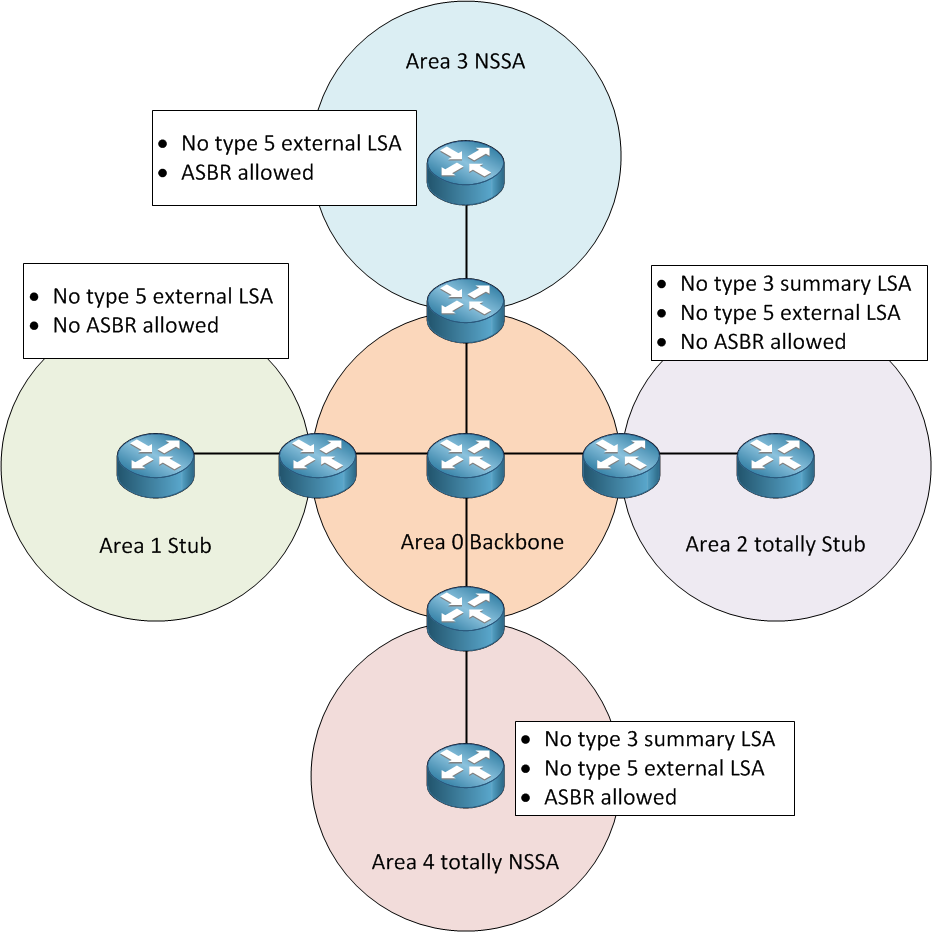OSPF has special area types called stub areas. In this lesson, I want to give you an overview of the different OSPF stub areas. Make sure you understand the different OSPF LSA types before you continue reading, or it might be difficult to follow me.
Let me start by summing up the special area types:
- Stub area
- Totally stub area
- NSSA (not so stubby area)
- Totally NSSA (totally not so stubby area)
Do you feel stubby now?
These special area types are used to insert default routes into an area and replace type 3 summary LSAs and type 5 external LSAs. This will keep the LSA flooding to a minimum, LSDB smaller, fewer SPF calculations, and a smaller routing table. Let me give you an overview of the different stub areas:

Let’s start with a nice topology with five areas. In the middle, you’ll find the backbone area, and the other areas are configured as different stub area types.
If you configure an area as a stub, it will block all type 5 external LSAs. All the prefixes you redistributed into OSPF from another routing protocol are not welcome in the stub area. Since you are not allowed to have type 5 external LSAs in the stub area, it’s also impossible to have an ASBR in the stub area. You can still learn networks from other OSPF areas.
Of course, there’s always an exception. So what if you want an area to be a stub area, but you also have an ASBR in this area? You can use the NSSA (not-so-stubby-area). This is the same thing as the stub area except that you are allowed to have an ASBR within the area. How does it work? This is where the type 7 external LSA kicks in. Since we are not allowed to use the type 5 external LSA, we’ll use a new LSA type.
What about totally stub? This area type will block type 5 external LSAs and type 3 summary LSAs. It’s impossible to have an ASBR in the totally stub area since type 5 external LSAs are blocked.
If you want to block type 3 summary LSAs and type 5 external LSAs but still need an ASBR within the totally stub area you can turn it into a totally NSSA (totally not-so-stubby-area). This will block both LSA types, but you can still have an ASBR in this area type.
Anything else you need to know? Here are some of the rules when dealing with the stub and totally stub areas:


Very good lesson to understand OSPF Special Area Types
Hello. I am wondering why and when to use Stub Area instead of Totally Stubby Area and viceversa ?
Hi Robert,
The stub area only blocks external prefixes, the totally stub area blocks external prefixes + inter-area routes.
Rene
Yeah I am aware of that in 100 % procent. But in what practical cases use those two area ? I actually have configured stub area ( it has all router belonging to particular autonomus system and default route) and I have also configured totally stubby area It has routes belonging to one area with default route. So why does stub area need those additional routes ?
really good info
thanks very much